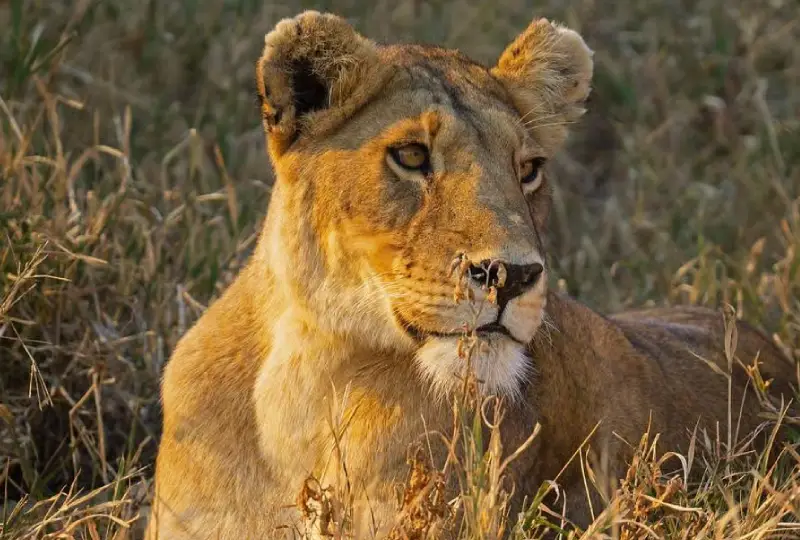Nyerere National Park Overview
Nyerere National Park, once part of the world-famous Selous Game Reserve, is among the largest protected areas in Africa and Tanzania’s newest national park. Stretching across more than 30,000 square kilometers, it is nearly four times the size of Serengeti, offering a true wilderness escape. The park is defined by the great Rufiji River, whose branching channels, wetlands, and oxbow lakes create a spectacular ecosystem. This rich environment allows for diverse safari activities that go beyond the traditional game drive, including boat excursions, walking safaris, and even fly camping under the stars.
The park is celebrated for its extraordinary wildlife. Large herds of elephants and buffalo roam the grasslands, while lions, leopards, and the endangered African wild dog add excitement to game viewing. The river teems with hippos and crocodiles, while more than 440 bird species, from colorful bee-eaters to majestic fish eagles, make the park a paradise for birdwatchers. Unlike the busier northern circuit parks, Nyerere offers an intimate and less crowded experience, making it a superb choice for travelers in search of authentic and unspoiled safari adventures.
Where is Nyerere National Park located?
Nyerere National Park lies in southern Tanzania, approximately 230 kilometers southwest of Dar es Salaam. It is part of the vast Selous ecosystem and is accessible both by air and by road. Flights from Dar es Salaam or Zanzibar to the park’s airstrips take about one hour, while road journeys last four to six hours depending on conditions.
What makes Nyerere National Park unique?
Nyerere stands out because of the diversity of experiences it offers. Visitors can glide down the Rufiji River on a boat safari, watching elephants and antelopes drink at the banks while crocodiles rest in the shallows. Walking safaris led by armed rangers reveal the smaller details of the bush, from animal tracks to traditional medicinal plants, offering a deeper connection with nature. Game drives provide the classic safari experience, while fly camping allows travelers to spend the night beneath a sky glittering with stars. This unique blend of landscapes savannahs, wetlands, forests, and waterways gives Nyerere a special character that few other parks can match.
What animals can be seen in Nyerere National Park?
Nyerere is home to a remarkable array of wildlife. Visitors often encounter elephants, giraffes, zebras, wildebeests, and buffalo on the open plains. Predators such as lions, leopards, and hyenas are common, while the park is one of the last strongholds of the rare African wild dog. Along the river, hippos and crocodiles are a constant presence, often creating dramatic encounters during boat excursions. Bird enthusiasts will be delighted by more than 440 recorded species, including kingfishers, hornbills, storks, and African fish eagles.
When is the best time to visit Nyerere National Park?
The best period to visit is during the dry season, from June to October, when animals congregate around the Rufiji River and other water sources, making sightings easier and more frequent. The roads within the park are also more accessible at this time. The wet season, which runs from November to May, transforms the landscape into lush greenery and provides outstanding opportunities for birdwatching, although some areas may be difficult to reach due to heavy rains.
How can travelers access Nyerere National Park?
Travelers can reach the park either by air or by road. Light aircraft flights from Dar es Salaam, Zanzibar, and Arusha land directly inside the park, making it an easy addition to safari itineraries. For those who prefer to travel overland, the road journey from Dar es Salaam provides an adventurous route through rural villages and scenic countryside, though it is best suited to those comfortable with rough terrain.
What safari activities are offered in Nyerere National Park?
Nyerere is one of the few parks in Tanzania where visitors can enjoy such a variety of safari activities. Traditional game drives allow guests to explore the savannah and woodlands in search of big game. Boat safaris along the Rufiji River provide a completely different perspective, bringing travelers close to pods of hippos, basking crocodiles, and abundant waterbirds. Walking safaris immerse visitors in the sights, sounds, and scents of the bush, while night game drives reveal nocturnal species such as civets, bush babies, and owls. Cultural visits to nearby villages can also be arranged, giving insight into local life and traditions.
Where can travelers stay in Nyerere National Park?
Accommodation in the park ranges from luxury lodges and exclusive tented camps to simple campsites for budget-conscious travelers. Many of the lodges are positioned along the Rufiji River, allowing guests to watch elephants, hippos, and other wildlife from their rooms or outdoor lounges. This range of options ensures that every type of traveler, from honeymooners seeking romance to families looking for adventure, can find a suitable place to stay.
How does Nyerere compare to other national parks in Tanzania?
Compared to Serengeti, which is best known for the Great Migration, Nyerere offers more diverse safari activities and far fewer visitors, giving it a sense of exclusivity. In contrast to Ruaha, which is rugged and remote, Nyerere’s waterways add variety and opportunities for boat safaris. This combination of vast landscapes, abundant wildlife, and diverse activities makes Nyerere one of Tanzania’s most rewarding and distinctive safari destinations.
Is Nyerere National Park safe for visitors?
Nyerere National Park is safe for travelers. Safaris are always conducted under the guidance of professional rangers and guides who ensure both safety and education during the experience. By following their instructions and respecting the park’s rules, visitors can enjoy their safari without concern while fully immersing themselves in the wonders of the African wilderness.

